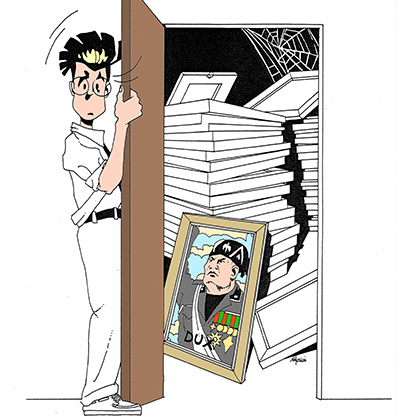Defensive strategies for avoiding the annoying problem of customers forgetting to come back and pick up their pictures. How to get rid of the "stock" and stop it happening again?
Each one of us must have had a customer, leave us a picture for framing, and then never be seen again. You find yourself left with a picture, inside a frame which you have spent time and money to prepare.
What's even worse is that it cannot be sold. How do you "force" the client to come back to pick up his framed picture. Above all how do you stop it happening again with other customers.

Let's first tackle the current emergency
If your back room is full of frames awaiting to be picked up then you should immediately pick up the phone and start calling all these clients. A call every 3 to 4 days should entice even the most reluctant customers to come pick up their frames.
Be diplomatic but firm on the phone. With the first call it is sufficient to state things like "We have one of your pictures that has been framed by us a while ago and we just wanted to remind you, in case you had forgotten, that it is here awaiting to be picked up".
If the customer had already left a deposit then you should remind them "I see that you have left a deposit of £10.00. We just wanted to remind you that you only owe us the balance". The next call however should be firmer but still courteous. "We are calling again to remind you that your framed picture is still here. If you are equipped, you could suggest that you will personally deliver the frame to their home for a minimal cost of £7.00.
With a third call you can even permit yourself to joke around. One framer I knew would state to his customers "After a while we give away these abandoned frames to charity. Would you like to donate yours as well or shall we wait a little longer?.
Be patient but persevere.
How to avoid it happening again?
By doing the round of phone calls, you have probably emptied out most of your back room. But now that you have overcome this problem, with a considerable loss of time and money, nothing assures you that it won't happen again. Here are some tips you could adopt in order to minimise the risk of it happening again.
|
1. |
|
The best way is to ask for a substantial deposit, probably around 30% of the frame's price especially if the picture to be framed isn't of great value. Don't worry about offending the customer. If you have a sign appended that is clearly visible to the customer and you act courteously but firmly, there will be few customers that will object. If, even these small tricks (the deposit) aren't enough to make the customer come back, then at least you have protected yourself. You have got their deposit and you have still got the material used to make the frame. The deposit should be recorded on both copies of the consignment docket. One copy goes to the customer whilst you keep the other. Remember to write the customer's name and phone number on the docket as this will make life easier if you were to pursue them later on. |
|
2. |
|
It is important to highlight the date of the expected completion time on the docket. You can even add an invitation to the customer to come pick it up at a precise date. Obviously these dates must then be respected. |
|
3. |
|
Finally it is necessary to shorten completion times. Pictures should be framed within 3-4 days, a week at the most. If you invite the customer to return within 15 days or more, then you risk the customer forgets it. You must remember that many customers decide to frame something on the spur of the moment or when they have a bit of spare cash. Don't make them lose their current enthusiasm. A lot of customers need just a small distraction or an unexpected expense for their interest to be lost. Anticipate the problem; beat them to it. |
The impossible customers
Even with all the precautions some framed pictures might still be left in your shop. What should you do in these circumstances? If you had wisely asked for a deposit, you will not find yourself in a totally negative situation because you will have partially amortised your loss. After a reasonable period of time (say 6 months) you could disassemble the frame and use it for another client. The picture would need to go in a lost corner of your back room just in case the customer has a last minute rethink. If you like the picture, maybe you could take it home. You could always give it back to the customer if he came back looking for it. It is not advisable to sell it because the customer even after many years could bring action against you. The worst thing is that he would be right.